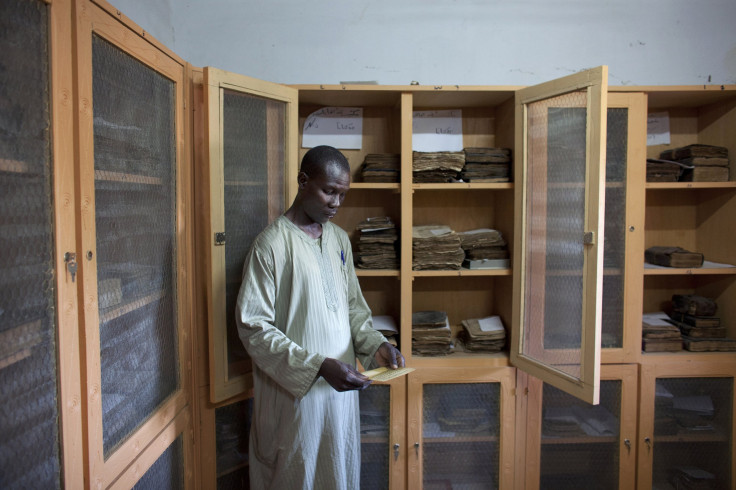Why Timbuktu Manuscript Burnings Should Offend All Africans

The United Nations Educational, Scientific and Cultural Organization, or Unesco, is set up to protect the world’s most outstanding cultural and natural treasures, but it can’t stop rebels in nations like Mali from destroying their own heritage.
Timbuktu Mayor Ousmane Halle told the Associated Press early Monday that extremists had committed yet another unthinkable crime in the historic desert town, torching a library devoted to saving Africa’s history from oblivion.
“It’s truly alarming that this has happened,” he said. “They torched all the important ancient manuscripts, the ancient books of geography and science. It is the history of Timbuktu, of its people.”
The library -- named the Ahmed Baba Institute after a Timbuktu-born contemporary of William Shakespeare -- opened in 2009 under a bilateral agreement between the South African and Malian governments to focus on the conservation, research and promotion of African manuscripts. It not only contained state-of-the-art resources for proper manuscript storage, but also conference rooms, accommodations and facilities for researchers.
In addition to the Institute, Halle claimed that his office and the home of a member of parliament were also destroyed over the weekend. He was unsure whether the rebels remained in Timbuktu Monday, though ground forces backed by French paratroopers took control of the airport and roads leading out of the city late Sunday night, according to French military officials.
France launched air strikes against Islamic camps and mobile forces in northern Mali two weeks ago to stop a rebel offensive and “safeguard” the nation, which was a French colony until 1960. The capital, Bamako, is still home to about 6,000 French citizens, and the landlocked West African country is France’s main source of uranium for its nuclear industry.
The conflict in Mali began in earnest at the beginning of 2012, when rebels imposed Shariah law in the north, banning things such as smoking and music and forcing women to wear headscarves. The hard-line Islamist groups Mujwa and Ansar Dine, backed by al Qaeda’s North African wing known as AQIM, moved into Timbuktu last June and defaced Sufi tombs inside a 15th-century mosque, calling the site blasphemous.
Unesco immediately placed it on its World Heritage in Danger list, though armed groups occupying Timbuktu systematically destroyed more artifacts in late December. Ansar Dine leader Abou Dardar told the AFP at the time that “not a single mausoleum will remain in Timbuktu; Allah doesn’t like it. We are in the process of smashing all the hidden mausoleums in the area.”
When French troops went into Mali earlier this month, Unesco Director-General Irina Bokova urged all armed forces to “make every effort to protect the cultural heritage of the country, which has already been severely damaged.”
Invoking the Hague Convention of 1954 for the Protection of Cultural Property during armed conflict, Bokova sent a letter to both Malian and French authorities encouraging them to respect its rules.
“Mali’s cultural heritage is a jewel whose protection is important for the whole of humanity,” she said, adding that the protection of cultural heritage “is an essential part of all sustainable efforts to build peace and respect for human rights.”
French troops, meanwhile, say they have been careful to avoid combat within the city itself so as not to damage its mosques, shrines and cultural treasures.
Unesco has put in place an emergency fund that it says will enable the organization to access, rehabilitate and reconstruct the damaged Malian sites at a future date. It has also distributed topographic features relative to the location of sites of concern.
Tuareg nomads founded the City of 333 Saints in 1100, and it grew from a small caravan stop to an important center of learning and the richest town in the ancient empire of Mali by the 14th century. It has enticed travelers for centuries and was a popular destination for adventure tourists and international scholars until three foreigners were kidnapped and another killed in a November 2011 attack claimed by AQIM.
Even after the kidnapping, Timbuktu remained a vital cultural center and home to more than 20,000 manuscripts covering topics from astronomy to poetry, music and medicine. Artifacts in Timbuktu date as far back as the 12th century and provide a unique record of sub-Saharan Africa’s medieval history, debunking antiquated ideas that Africa’s cultures were “primitive” or “lacked history and literature.”
As the situation deteriorated last year, some documents were hidden from the radical Islamists, stored in underground vaults or removed. But many others stored in the Ahmed Baba Institute are now gone forever.
© Copyright IBTimes 2024. All rights reserved.






















